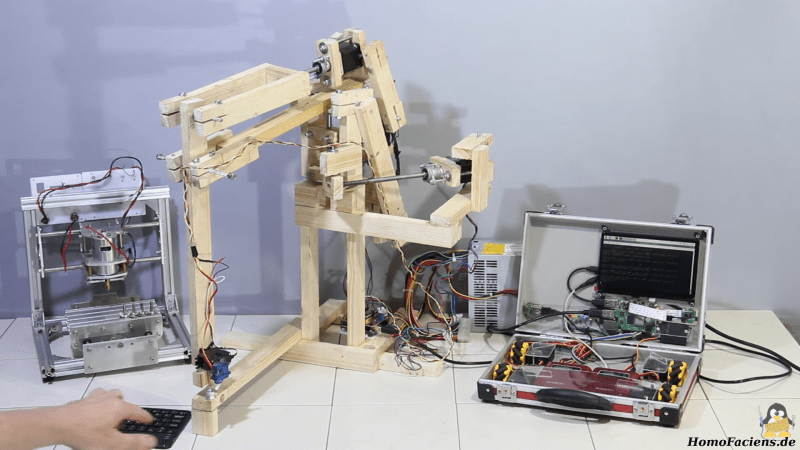There’s nothing like a little weekend project, especially one that ends up better than you expected. And when you literally build a robotic arm out of workshop scraps, so much the better.
Longtime readers will no doubt recognize the build style used here as that of [Norbert Heinz], aka “Homofaciens” on YouTube. [Norbert] has a way of making trash do his bidding, and has shown us all kinds of seemingly impossible feats of mechatronics with just what’s lying around. In this case, his robot arm is made from scrap wooden roofing battens, or what we’d call furring strips here in the US. The softwood isn’t something you’d think would make a great material for building robots, but [Norbert] makes its characteristics work for him, like using wax-lubricated holes for hinge points. Steppers and lead screws cannibalized from an old CNC build, along with the drive electronics, provide the motion. It’s a bit — compliant — but precise enough to pick up nuts and stack them nicely. The video below gives an overview of the build, and detailed instructions are available too.
We always appreciated [Norbert]’s minimalist builds, and seeing what can be accomplished with almost nothing is always inspirational. If you’re not familiar with his work, check out his cardboard and paperclip CNC plotter, his tin can encoders, or his plasma-powered printer.
















That is neat. I wonder how many of us think of using ‘wood’ for a robot arm…. I know I was thinking of having to design some 3D printed parts (or buy an already built)….. We have a saying in computer science that applies here I think “Keep it Simple Stupid” (Kiss principle). Anyway I enjoyed the video. Thx!
Here is another one:
https://hackaday.com/2019/03/14/wood-scara-arm-gets-a-grip/
Slightly different ballpark though :).
I made a robot arm for high school science Olympiad out of the free rulers you get a Lowes. I’m pretty sure I picked that material because I didn’t want to buy a measuring tape
hehehe, I like that reasoning… I wonder how many such things you can take before they object, as its actually a really neat idea, self measuring stock…
This is fantastic. Great to see that cheap wood battens and long screw rods can provide a suitable frame for mechatronic experiments of the kind of precision shown in the video. Impressive indeed, thanks for sharing!
Thanks Dan for the blog entry!
From time to time I get requests for help from parts of the world where the 3D printer density isn’t as high as in Europe or the US. Their kind of copying isn’t downloading stl files and put it all together. It is always creating common machines from scratch with what those students can get and lots of brain for the details. With that, wooden robotic arms aren’t that unusual to me ;-)
Love the bot. The use of screws and linkages in place of gears is inspired and inspiring. It looks a bit like a backhoe (“bagger”) mechanism, where the screws substitute for those pneumatic cylinders.